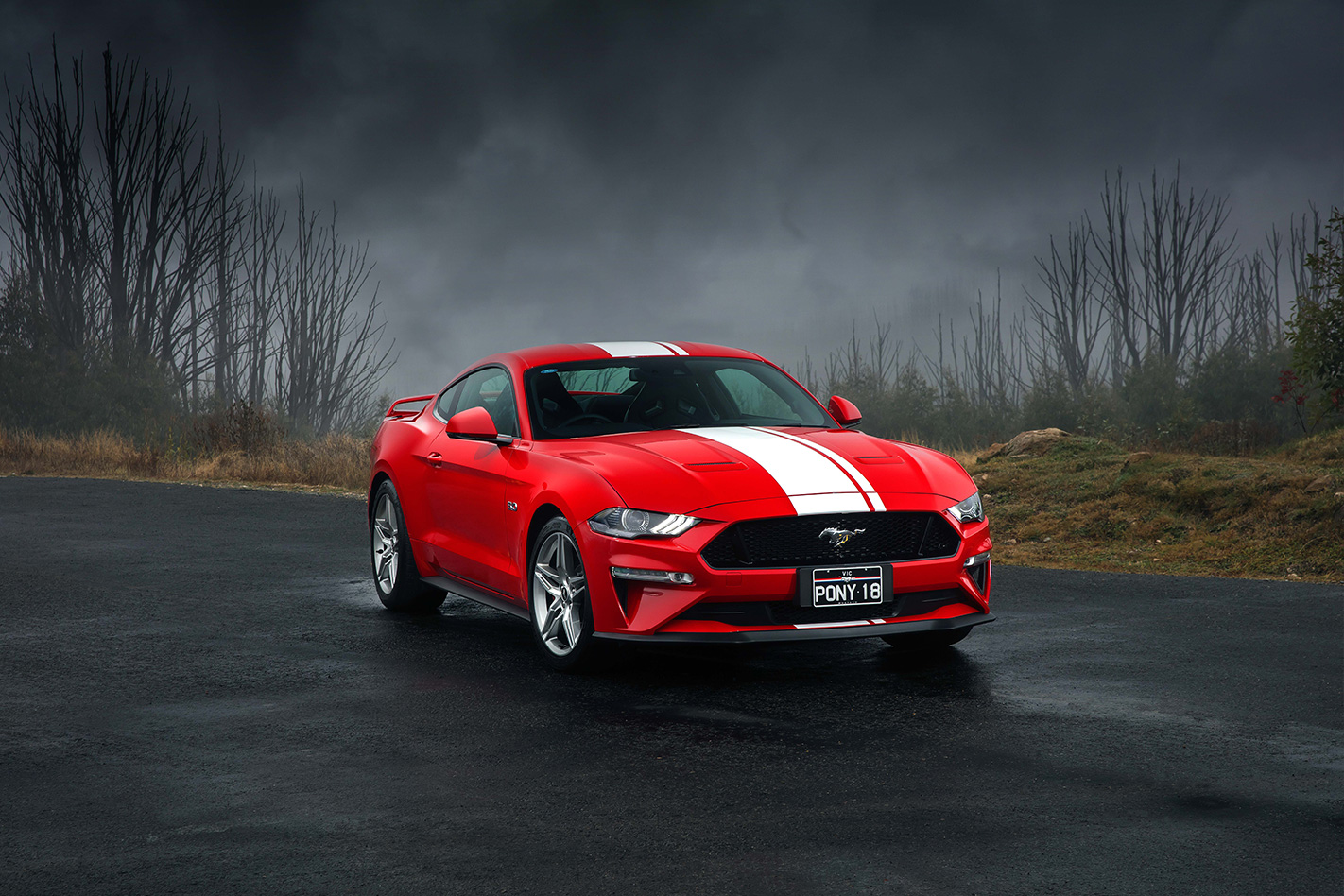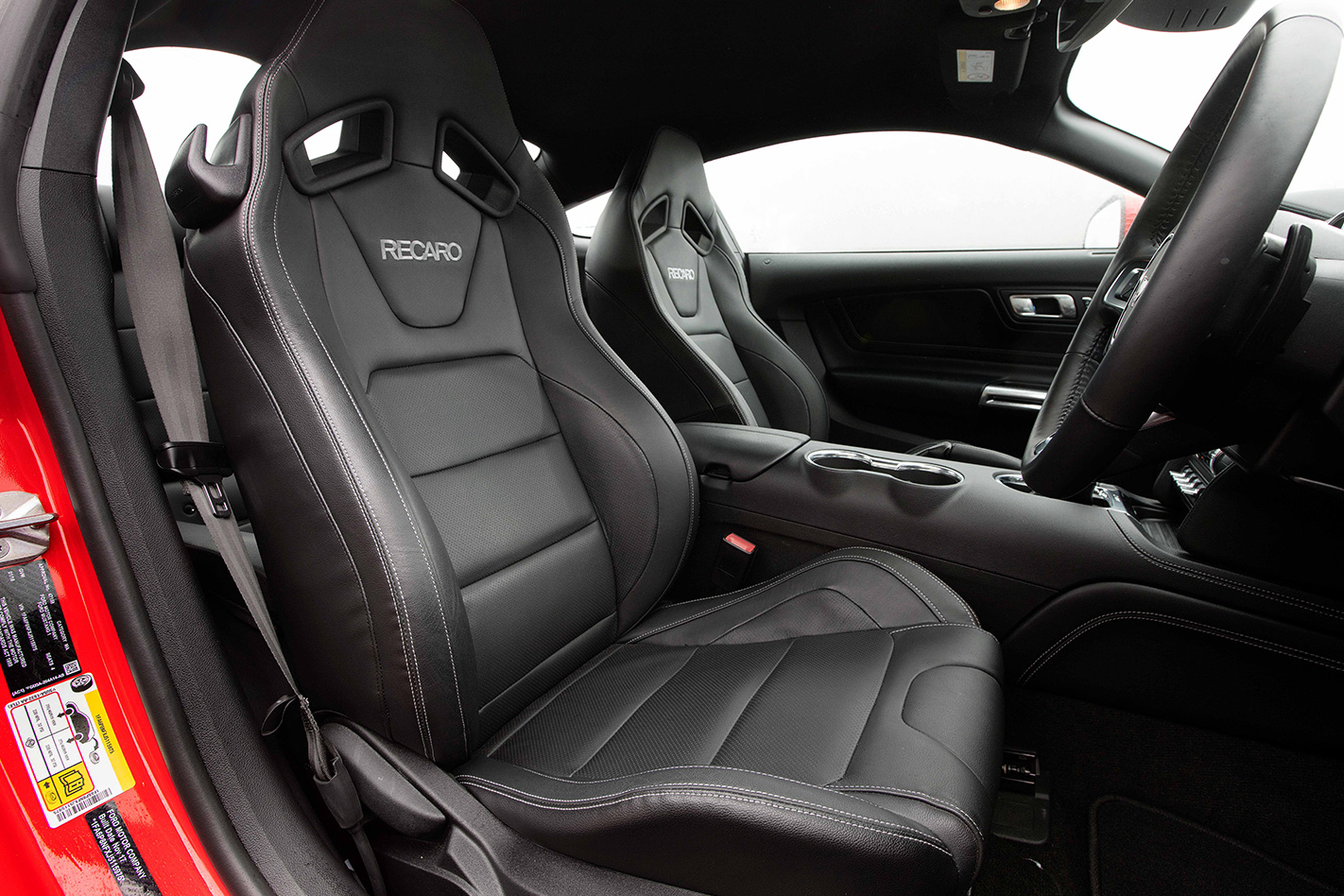WHAT IS IT?
The first update of 2015’s sixth-generation Mustang, incorporating improvements to its NCAP safety rating (now a not-quite-as-crap three stars in Oz due to its not-so-special head protection for children travelling in the back on booster seats, but improved due to standard AEB and collision alert across the board), and a concerted effort to make it sportier, fruitier, more efficient and less Yank-tastic inside its slightly contrived cabin.

WHY WE’RE TESTING IT?
Endowing Australia’s favourite sports car with larger balls, while letting us loose on the new Tailem Bend race circuit 100km south-east of Adelaide, says the Blue Oval is confident the MY18 Mustang has the stamina to fulfil the brief. There’s also a new 10-speed automatic ’box that Ford claims is the duck’s guts, and an active-valve exhaust system pinched from the US Shelby model for proper ear-shattering V8 acoustics. We hope.
MAIN RIVALS
At top-end GT level with every option thrown at it (approaching $10K’s worth), the Mustang’s sole coupe rivals are the BMW M240i ($78K) and HSV’s forthcoming Chevrolet Camaro SS, which the Clayton outfit will be performing the right-hand conversion on. But at $50K, the Mustang Ecoboost (due September) is more of a BMW 220i coupe rival, as well as a larger alternative to a range-topping Toyota 86/Subaru BRZ.
THE WHEELS VERDICT
It might look only vaguely different to its three-year-old predecessor, but the MY18 Mustang is a transformed car. It’s faster, better finished, more precise to drive, with steering that actually feels connected to the front wheels, and an exhaust note packed with meat. Ford’s new 10-speed auto is also a cracker, if not entirely without flaws. Yet for all its improvements, the slicker MY18 Mustang is somehow less endearing than its rough-and-ready predecessor. It doesn’t look as tough, and the lack of a visual bonnet bulge from inside the car means it doesn’t feel as tough – or as intimidating – as it used to. Can’t stop progress!

PLUS: Louder V8 acoustics; classier interior; effective and interesting new technology; (mostly) excellent 10-speed auto; steering and body control both transformed MINUS: Sleek new front has lost some of the previous model’s snouty menace; cabin embellishment still overdone; optional Recaro buckets lose seat heating/cooling
THE WHEELS REVIEW
YOU KNOW there’s something in the air when the Ford Mustang sells nearly 10,000 cars in a full year, reinforcing what we’ve always known – Aussies love muscle cars. So if that’s the case with the existing car – one that prompted a waiting list that stretched for months when it launched back in December 2015 – then how is this fresher, classier, better-equipped and sharper-driving 2018 version going to fare?
Gone is the almost unbelievable entry price of the previous car. Instead, today’s Mustang Ecoboost six-speed manual (due here in September) with a slightly torquier 224kW/441Nm 2.3-litre turbo-petrol four and new-design 19s will set you back $49,990 before on-road costs, while the meaty 339kW/556Nm V8-engined Mustang GT (on sale now) kicks off at $62,990. Both MY18 engines offer the option of a brand-spanking 10-speed automatic (jointly developed with GM, but with hardware and calibration unique to Ford) for three-grand extra.

For those slightly elevated stickers you get a truckload of sparkly new features, starting with the proper full-LED headlight arrangement of the US car (with tri-strip DRLs), styled to mimic the intricacy of an actual eagle’s eye, and a full-digital 12.4-inch instrument pack that turfs the daggy old analogue set-up into a dumpster somewhere in the backlots of Detroit.
Yet for all its newfangled glamour, there’s a tangible dose of heritage in the three types of instrument styles on offer in the digital screen – the ‘Racetrack’ version featuring a strip-like tacho that curls up from the left and across the upper dial section, like a speedo from a ’60s T-Bird – and you can change the ambient cabin lighting too, all via the Mustang symbol on the right-hand wheel spoke. It’s both dead-simple and totally on-trend, while leaving sat-nav map duties (if not directions) solely to the SYNC3 screen in the dash centre.
Soft-touch plastics now garnish the door trims, while new stitched trim coats the entire centre console. In fact, everything you touch, either via fingers or elbows, has been given the ‘soft-touch’ treatment, including a cushier centre armrest, plusher door armrests with tactile stitched-leather trim, and higher-grade, more supple leather on Mustang’s carry-over three-spoke steering wheel.

Apparently that’s what Europe and Australia demanded, so the best interior on offer in the US is what we get. The previous model shared its interior plastics supplier with the F-Series truck and, well, we know how that turned out.
Approaching the MY18 Mustang, it isn’t immediately obvious that much has changed. Yet there’s actually been quite a lot of visual surgery at the front end. Those aforementioned headlights combine with horizontal fog lights, a 65mm-wider grille (with just one V8 design for export) and a 25mm-lower bonnet line to make it look much sleeker (and marginally more aerodynamic), if slightly less intimidating. At the rear, funky new taillights with jagged edges, a new lower appliqué, and quad exhaust pipes give the MY18 Pony Car a fresh look to match its super-fruity new sound.

And what a sound. Even fitted with an optional Ford Performance exhaust system, the previous 5.0 simply didn’t have the audible muscle, or the bottom-end shove, that muscle-car buyers wanted. But Ford’s obedient Yank engineers have more than made up for that lack of bent-eight burble by filtering down the Shelby GT350’s active-valve exhaust system (which opens the pipes at 1750rpm) for a comparatively ear-shattering experience.
On the upper two of four exhaust settings (Sport and Racetrack, not the demure Normal or insipid Quiet modes, all easily accessible via the Mustang steering wheel button), the MY18 V8 is a riot of exhaust bark. Indeed, the Racetrack version is arguably a bit too brutal for consistent 120km/h freeway running when under load, though we really shouldn’t be complaining. And while there’s little of the overrun crackle and pop that characterised Holden’s much-loved and much-missed VFII SS-V Redline, the MY18 V8’s thunder is exactly what us petrolheads were begging for.
Even the Ecoboost will get the active-valve exhaust – introducing a “snarl”, according to Global Chief Program Engineer, Carl Widmann – so there won’t be an MY18 Mustang in the stable that doesn’t deliver a good dose of aural sex.
Mechanically, it’s the volume-selling V8 that cops all the engineering enhancements. Direct and port fuel injection, a higher compression ratio (up from 11.1 to 12.1:1), revised heads with larger intake and exhaust valves (improving flow by four percent) and even a larger 93.0mm bore diameter from the Shelby GT350 that lifts capacity to 5038cc (was 4951cc) and outputs to a far more palatable 339kW at 7000rpm (up 33kW) and 556Nm at 4600rpm (up 26Nm), makes the MY18 car feel much spritelier.

She’ll now rev to beyond 7000rpm (redline is seven-four; cut-out seven-five), but there’s still little point going right to the absolute top-end. The Mustang GT definitely feels stronger though, with a preliminary claim of 4.3sec to 100km/h for the new 10-speed auto with launch control. And what a great auto. Ticking along at just under 2000rpm at 120km/h in top, it’s arguably the only mega-ratio self-shifter that’s able to use its entire ratio set in a country like ours. And besides the odd fluffed shift or dithered kickdown in moderate-pace driving, it’s just about flawless.
At South Australia’s new Tailem Bend racetrack, a simple nudge of the transmission lever into ‘S’ allowed the auto to choose its ratios with absolute perfection, lap after lap. And if you start fiddling with the shift paddles when in Sport mode, it’ll even hold gears at redline without shifting up.
The six-speed manual has also been put through a workout program. A dual-mass flywheel with a twin-disc clutch makes for much lighter shift action, and every ratio has altered (in a taller direction), with sixth being the closest to the old car’s gearing. Having spent many months in the previous GT manual, I kinda miss the oiled meatiness of the former shift, though the MY18 manual is near foolproof in its operation and much less reliant on perfect clutch technique.
Yet for all its newfound tactility and aural quality, it’s the MY18 Mustang’s vast dynamic improvement that makes it feel half a generation newer than the previous beast. The only cars we drove on the road were fitted with optional ‘MagneRide’ adaptive magnetic dampers ($2750), and while even Normal mode delivers a firm ride, with some knobbliness over certain surfaces and noticeable tyre noise, there’s been a huge improvement in wheel and body control. And the MY18’s new Michelin Pilot Sport 4 Ss – 255/40ZR19 front and 275/40ZR19 rear, on optional five-spoke forged 19s in this instance ($2500) –are excellent. They feel grippier than the previous Pirelli P Zeros and are designed to be more effective across a broader temperature range, as well as in wet conditions.

Up front, the strut arrangement and forged-aluminium lower control arms from the Shelby GT350 have significantly strengthened the entire set-up, making the Mustang feel much tauter, with far superior steering response. In conjunction with retuned electric steering assistance, the annoying vagueness and on-centre mush of the old car has given way to far more accurate and confident direction control. It’s as if Ford of Europe (or Australia) waved a magic wand over the beast and ‘hey presto’, Ford’s global dynamic DNA is suddenly front and centre. The clippety-clop wheel patter and vertical suspension movement of the 2015 car is now a distant, if slightly rose-tinted, memory.
The MY18 Mustang is still a sports coupe, though, so what feels firm in Normal damping mode becomes very firm in Sports mode (with better front-to-rear balance and sharper turn-in) and frigging firm in Racetrack. That said, this is a car that can cop some consistent pounding around a circuit, carry-over Brembo brakes included, so it’s entirely in keeping with what buyers want. And if it’s the auto-only convertible you’re after, then a slightly softer-feeling ride is probably a reasonable trade-off for the bodystyle’s slightly flexy, open-top experience … at which point the V8’s newfound exhaust burble sounds addictively delicious.

About the only contentious alteration in the new car is the eradication of the previous Mustang’s bonnet bulge. That prominent visual signature was such a large part of the character of the old car that looking over a rather flat bonnet (with kinda tacked-on bonnet vents) makes the MY18 car feel like it has a lower cowl. Or that you’re sitting higher. Neither of those things are true, though given the facelifted car’s vast improvements in so many areas, it’s an acceptable trade-off if this is the driving experience that goes with it.
The 2018 Mustang GT may not be quite as tough looking as before – especially wearing the lighter, stronger, yet rather plain-looking silver forged alloys of our test cars, not the carry-over black mesh 19s that will be standard – yet it has been transformed in so many areas. It’s no longer an endearingly flawed, huggable beast of a thing that you need to make excuses for. Instead, it’s a seriously focused, much more European-flavoured (though thankfully still American-hearted) muscle car worthy of rear-drive, bent-eight adoration.

FORD MUSTANG GT SPECS
Model: Ford Mustang GT Fastback Engine: 5038cc V8 (90°), dohc, 32v Max power: 339kW @ 7000rpm Max torque: 556Nm @ 4600rpm Transmission: 10-speed automatic L/W/H/WB: 4789/1916/1382/2720mm Weight: 1681kg 0-100km/h: 4.3sec (claimed) Economy: 12.7L/100km Price: $65,990 On sale: Now





